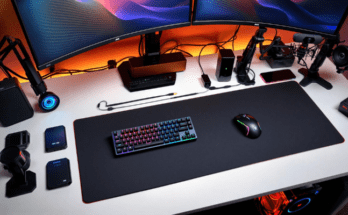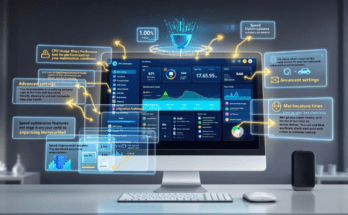Introduction
The most crucial part of any computer system is the inner equipment it comprises; known as the computer hardware. For someone who has never put together a computer, this is an interesting job because you get to learn many things about the device. These are the computer components which you as a reader of this article should have knowledge in the process of building a custom rig. In this case, we will look at the main subsystems that include the system unit, central processing unit, memory, storage devices and power. Also to this we will also discuss other equally important parts such as Graphic cards and Casing. That is exactly why this guide can come in handy for both beginners and those who try to know as much as possible about their computer.
1. Motherboard: The Heart of Your PC
Mainboard or system board, known as the motherboard is one of the most important components of any computing system. It is a thin board on which all the computers parts are mounted and through which they are connected and exchange data. Motherboard is the main task of its conveying electrical equipment and also helping to talk in the CPU, RAM, storage, and different gear.
Some of the attributes include chipset; form factor; the number of PCIe slots; the number of RAM slots; and kind of ports such as the Universal Serial Bus, high-definition multimedia interface, and audio connectors. This choice can greatly affect the way of expand and upgrade of a computer in the future, so it is advisable to choose the most suitable motherboard for you.
2. Central Processing Unit (CPU): The Brain of Your PC
The Central Processing Unit (CPU) is a device commonly known as the heart of some computer. It is a device for performing specialized operations for calculations, for executing commands or fundamental I\/O handling. CPUs have different models, and also differ in terms of performance, understood either in terms of number of cores, clock frequency, or the instruction set architecture or ISA.
As for the choice of the processor, you have to define what kind of operations you are going to solve with the help of your computer and how much money you are ready to spend. The different CPUs are put into different levels based on how much they would want the computer used on them, whether high end CPUs are used for gaming playing, video editing, while normal CPUs are okay for normal usage like browsing on the internet, typing documents.
3. Random Access Memory (RAM): The RAM of your Personal Computer
RAM or Random Access Memory is actually the temporary storage of your computer and any information on it can be viewed and modified. It contains information that your CPU has to complete its tasks effectively. RAM on the other hand is volatile, this means that when you turn off your computer, the RAM is erased. There are two main types of RAM: comparing to SRAM, DRAM is a type of RAM which is used for every modern computer. DRAM is the most frequently used RAM type that is present in today’s computers mainly because of the higher density and the relatively lower cost.
If you are using it for basic applications, then the amount of RAM you will require will be different from when you are using it for larger applications like complex business applications. 8GB of RAM will be more than enough if you use the computer for the most normal stuff such as surfing the web and typing out documents. But for intensive applications such as gaming, video or photo/video editing, 3D rendering etc you may wish to go for the RAM of not less than 16 GB or even higher.
4. Storage: The Life Log that is recorded by the PC of each and everybody is the extended suggestion of the memory of Your PC
A storage is the specific part of a computer that stores information even when the computer is switch of. There are two main types of storage: its categories that consist of hard disk drive (HDDs) and solid-state drives (SSDs). While an HDD consists of spinning disks on which data is stored, an SSD has interconnected flash memory chips. SSDs are already known to be faster and more reliable and use less power as compared to our old friend the HDD. However, they are also more expensive: for instance, a piece of plastic furniture costs more than a wooden one of the same design.
The nature of storing will determine the strategic type of storage to adopt depending on ones usage and budget. For those with simple calculations, 1Tera Byte Hard Disk Drive will suffice well in the computation needs of an organization. For a professional or an enthusiast, who wants to get the maximum productivity or simply be able to load games in a few seconds, it makes sense to purchase at least 512GB or more SSD.
5. Power Supply Unit (PSU): The Fuel for Your PC
The Power Supply Unit (PSU) helps in regulating electrical power from the actual wall socket outputs suitable for the parts in a computer system by changing mains voltage to low voltage DC. The PSU also occupies the central position in the longevity of your PC because it needs to deliver enough juice while also safeguarding your components from electrical fluctuations.
When choosing the PSU, the wattage must be carefully selected together with its efficiency (in percentage will be provided by the 80 PLUS program). You should also read the reviews to ensure you find the best PSUs from respectable brands. Recommended: Choose one with an 80 PLUS Bronze rating or higher and one with sufficient wattage to handle your computer parts now and in the future.
6. Graphics Card (GPU): The Visuals of Your PC
Another component called video card or graphic card helps to render images, video and animations in our system. It will enable elevated performance especially in task that focus on the visualization relationship, for instance, gaming, video editing and 3D rendering among others. GPUs are available in different types and what is produced depends on the number of cores, operating frequency, and the size of available RAM.
For Intense or professional uses, integrated graphics processors that are built into the CPU are sufficient but could be detrimental if you are an enthusiast so having a dedicated graphic card will be very key in as much as visuals are concerned.
7. Computer Case: The Home of Your PC
The computer case may also be commonly known as the enclosure or chassis; it is in essence the body of your personal computer. Both passively and actively cooled cases are available, and the sizes are from mini-ITX to micro-ATX and up to ATX. The cases have their own designs regarding where the vents and where to place the cable paths, which can affect how well the cooling is and even sleeving your computer.
Considering the case, several factors should come into your mind which are the cost, size of the components you intend to use and your preferences. Also ensure that this particular case has enough vents or wholes to allow proper airflow and this just helps prevent your computer from overheating.
Conclusion
While building your own computer can be quite enjoyable and handy to have, the effort depends highly on building your own computer if you aren’t familiar with computer hardware. In this article, you have been informed of the basics elements needed to construct a working computer system. Just keep in mind that choosing the right components for the system depends on needs, preferences as well as your pocket. So, now that you are familiar with components where computer depends on, you are welcome to try assembling your own pc. Happy computing!



